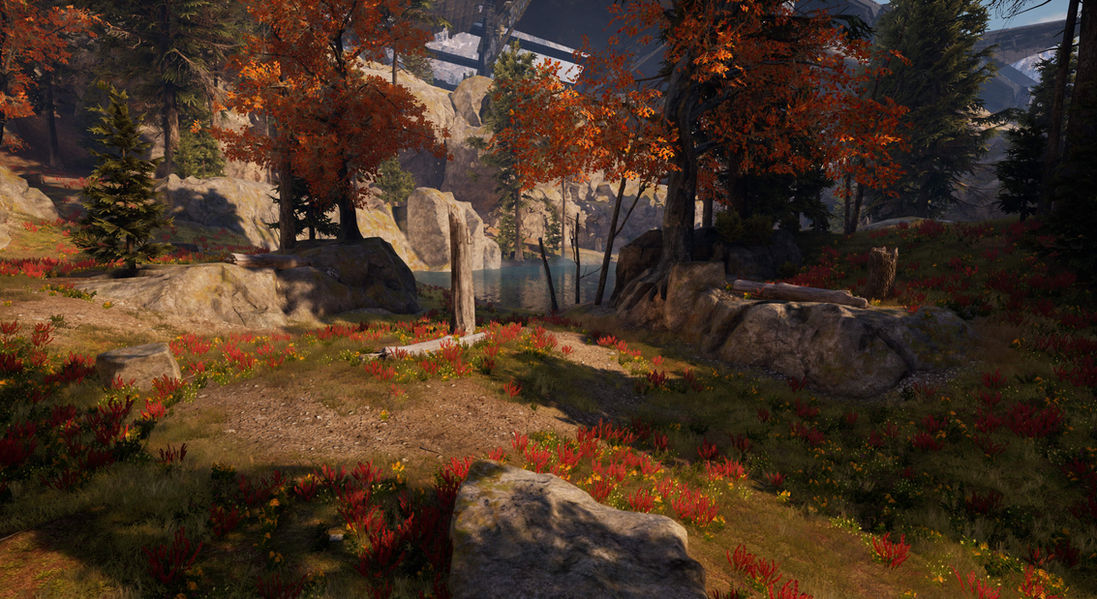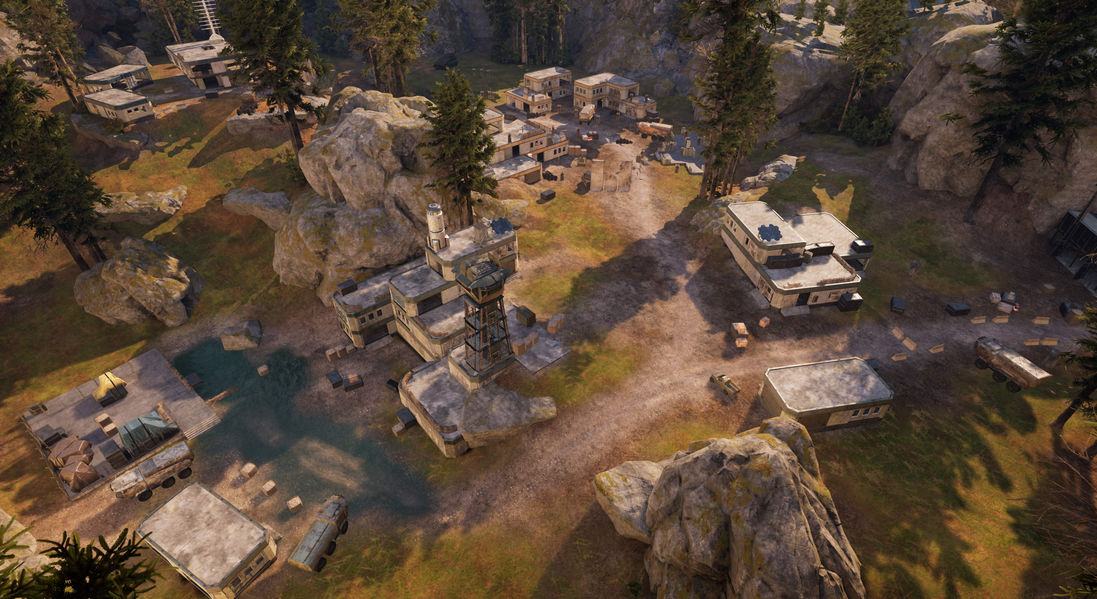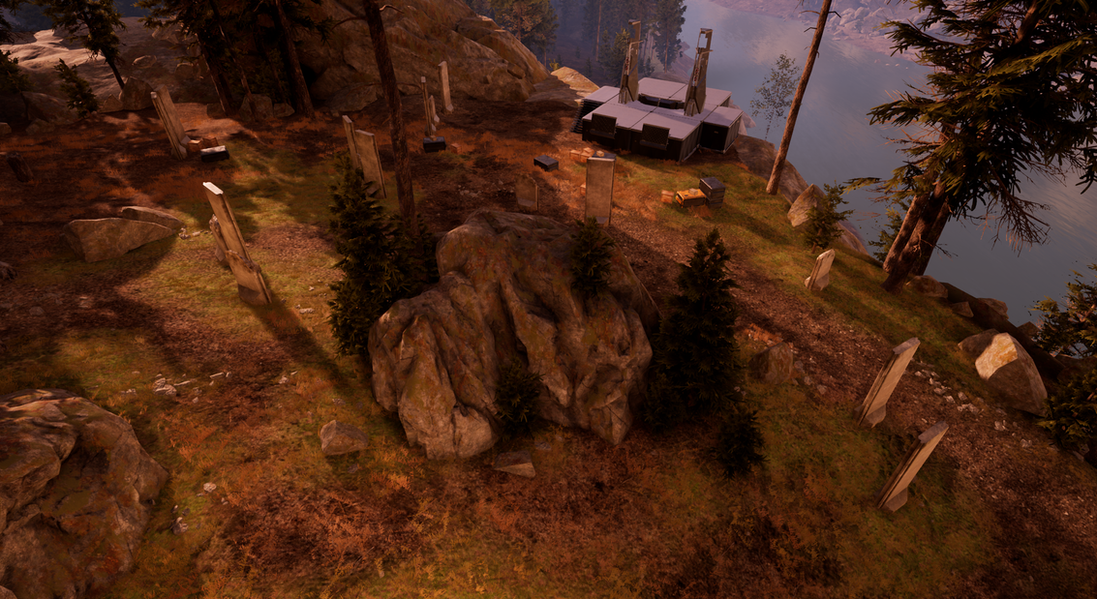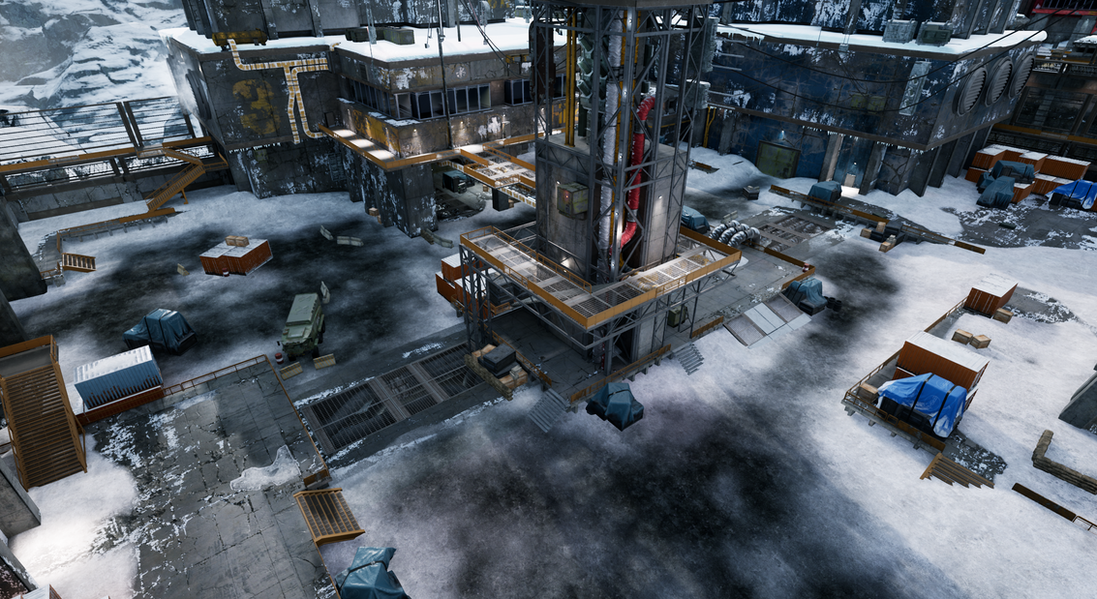
DISINTEGRATION
V1 Interactive
PvE Design Lead
(Playstation 4, Xbox One, PC | FPS / RTS Hybrid)
June 2020
Stagger System
Evade/Dodge/Brace System
Commanded Unit AI
PvE Enemy AI
"Back In The Saddle"
"One Man's Trash"
"Waggoner's Itch"
"The Gun Show"
"The Long Game"
"Gravcycle Training Center" (Tutorial)
Lesney Bay (PvP)
Back In The Saddle (PvE)
One Man's Trash (PvE)
Waggoner's Itch (PvE)
The Gun Show (PvE)
The Long Game (PvE)
SYSTEMS DESIGN
Stagger System
While working on improving the overall game-feel, I identified a need for more depth in our combat loop. I was inspired after seeing the first working enemy knock-back animation, and wanted to find a way to further accentuate those feel-good moments. I pitched a proposal for the Stagger System, which was greenlit for prototyping. The Stagger System became a catalyst for expanding and improving other combat gameplay systems.
Staggering an enemy causes them to take Critical Damage and maximizes the amount of damage the player’s squad is capable of inflicting. A primary goal in designing this system was to give players ample opportunity and a range of options to Stagger targets in the heat of battle. Staggers can be triggered by certain Unit Abilities, explosives in the environment, shooting enemies in the back/side or when other nearby enemies are killed and subsequently explode. They can also be modified by some Unit Abilities.
The Stagger System scales up and down relative to campaign difficulty settings. Successful play at higher difficulties requires mastery of the Stagger System along with efficient and strategic Unit Ability usage, as enemies will be more resistant to incoming damage and will regenerate their health more quickly.
Responsibilities
Managed and balanced all system tunings, including the Critical Damage modifier, durations of Stagger types and cooldowns
Defined required tunable parameters to balance and scale system based on difficulty levels, in coordination with engineering
Coordinated audio integration to support system design and feedback
Coordinated integration of system HUD feedback for player-facing clarity
Directed custom shader creation to convey Critical Damage dealt during Stagger state, in coordination with character art
Evade/Dodge/Brace Systems
After the Stagger System was implemented, I identified another opportunity to encourage players to plan their attacks more intentionally, by increasing enemy self-preservation through additional defensive behaviors:
EVADE: Enemies will attempt to side-step incoming damage.
DODGE: Enemies will attempt to roll out of the way of a nearby explosion.
BRACE: Enemies will take a defensive stance, reducing incoming damage. Enemies will Brace if they are too close to an explosion to Dodge, or cannot Dodge due to their enemy type.
A design goal of Disintegration was to achieve a high level of combat spectacle and watchability. The addition of the Evade/Dodge/Brace Systems increased the perceived intelligence of enemies in battle, while also adding moments of visual interest such as enemies catapulting through the air after failing to Dodge an explosion.
The Evade/Dodge/Brace Systems scale up and down relative to campaign difficulty settings. The higher difficulties will see enemies Evading/Dodging/Bracing more frequently and with shorter cooldowns between uses.
Responsibilities
Implemented and tuned Evade/Dodge/Brace behavior for all applicable unit types, across all difficulties. This included:
Damage thresholds and associated parameters for Evade events
Distance thresholds and associated parameters for Dodge/Brace events
Damage modifiers for Brace events
Dice-rolls and cooldowns for Evade/Dodge/Brace events
"Some of the main tools in your arsenal are unit abilities, and these are deeply satisfying when used to good effect: landing a mortar barrage on a bunched-up group of enemies results in a satisfying crunch of robot bodies, while a time-slowing dome creates a shimmering Matrix moment amidst the disorder."
Eurogamer
"There's always something else you can finesse: once you've got your aim right, you can think about how to deploy special abilities to maximum effect. Once you've learned how to respond to certain enemy types, you work on exploiting the mobility of the Gravcycle to quickly manoeuvre through the battlefield."
Eurogamer
AI DESIGN
Commanded Unit AI
As a Gravcycle Pilot, players need a quick and intuitive way to interface with their Commanded Units on the ground. The goal was to give players enough tools to make strategic decisions during battle, but not so many as to overwhelm them.
PRIMARY PULSE ORDER: The player’s squad will move to the selected location and fight intelligently from there. If nearby cover is available, they will use it. If not, they will attempt to find an advantageous position to fight from, utilizing elevation and other elements of the environment to protect them.
PRIORITY TARGETING ORDER: The player’s squad will shift focus to the selected enemy, making moving to and shooting at the designated target their highest priority. They will ignore cover during this order to make their response time and aggressiveness as immediate and impactful as possible. Due to the risk of exposure to incoming damage, this command is meant for quick and strategic use during combat, especially against a target that has been Staggered.
FOLLOW MODE: The default state of the player’s Commanded Units, they will maintain a close distance in front of the Gravcycle while navigating the world. Once combat is initiated, the squad will have a wider area to operate within. This allows Commanded Units to fight strategically according to their strengths, with some charging in close-range for melee attacks and longer-ranged units keeping safe distance.
Follow Mode is overridden by Primary Pulse Orders and Priority Targeting Orders. When a Priority Targeting Order is issued, the squad will automatically return to Follow Mode after the priority target has been killed.
Responsibilities
Designed and implemented all AI behavior for each Unit Command type
Tuned all parameters related to Unit Command types
Created custom EQS tests for Unit Command types
Tuned targeting behavior parameters
Tuned cover selection behavior

PvE Enemy AI
Disintegration features 12 enemy types, each with unique AI behavior:
Small Units
Riot Bot: Fodder enemies of low intelligence and durability. Easy to take down but dangerous in groups. The Riot Bot's weapon is a Shock Baton which will temporarily stun anyone on the receiving end of it.
Merc: Medium-ranged unit that tends to fight from cover but will attempt to flee if taking too much damage. Mercs’ Autonomous Abilities are Mines, which they will place in defensive positions. Highly evasive, but relatively easy to take down. Dangerous in groups.
Merc Elite: Medium-long ranged unit that prefers to fight from cover or behind other enemy units. Self-preservation is a priority. Their Autonomous Ability is a Seeking Heal for other enemy units. When defeated, Elites drop a Heal Field that can be used by players, encouraging them to move into the fight. This field will regen the player’s (and their squad’s) health and Unit Abilities.
Sniper: Long-ranged units with a devastating sniper rifle. Snipers prioritize flying units. When the player sees their red laser activate, it means they’re moments away from taking a shot. Their Autonomous Ability is a Disruptor Drone, which will seek out an aerial target and temporarily jam weapons and the player’s HUD. Players can shoot the Disruptor Drone to cancel the ability.
Medium Units
Destroyer: Destroyers have significant offensive firepower and favor targeting Gravcycles, but still engage with ground units. They can sustain quite a beating, but can be taken down with strategic use of the player’s squad’s Unit Abilities. Destroyers’ Autonomous Ability is a Seeking Rocket Barrage, which can quickly take out a light Gravcycle or the player’s Commanded Units. They will fight from range until they get below ~50% health, at which point they will push aggressively on their target and circle-strafe to catch them off-guard.
WMD: A walking bomb, these units will begin to overheat and explode under sustained fire, but will recover quickly when left alone. They are easily Staggered by small-arms fire. If WMDs get close enough to their target, they will self-detonate.
Turret: Stationary turrets that are heavily fortified and armed with a Javelin Launcher that will slow anything it hits. Turrets have a limited range of motion, making getting around/behind them the safest way for the player to destroy them.
Large Units
Rhino: Defensive juggernauts with a massive health pool and brutal melee attacks that will temporarily stun their targets. Rhinos are slower-moving and very susceptible to being shot from behind for a Stagger. Their Autonomous Ability is a Shockwave Ground Slam that causes a cascading line of explosions. Rhinos also pose a threat to the player’s Gravcycle, as they are tall enough to take swings at aerial targets.
Thunderhead: The largest enemy unit in the game, these hulking machines are capable of firing a large barrage of seeking missiles from range, in addition to executing a Ground Slam that will destroy anything nearby. After Thunderheads have sustained significant damage, they will enter a downed state where they begin to regenerate health. In the downed state, four cooling nodes are exposed that players can destroy to kill the Thunderhead.
Aerial Units
Watcher: The Watcher’s role is an alert system first, attacker second. If they detect a threat, they will quickly close the distance and raise their alarm siren once confirmed. Players have a window to destroy a Watcher before their alarm is completed. If not destroyed, they will move to medium range and attack using their on-board weapons.
Wasp: With a balance of both offensive weapons and a moderate health pool, these units can do a lot of damage in a short period of time. Their weapon is a dual Javelin Launcher, which slows targets.
Gravcycles (Light/Medium/Heavy): There are three enemy Gravcycle chassis in the game: light, medium and heavy. Each type has their own unique on-board weaponry, from light machine guns and heat-seeking rockets, to grenade launchers. They will prioritize other Gravcycles in combat and are capable of Boosting around to evade fire.
Responsibilities
Designed and implemented all AI behavior for each enemy type
Created custom EQS tests for each unit type, where applicable
Created and tuned unit targeting behavior
Tuned cover selection parameters
Tuned Autonomous Ability usage
Designed the Merc Elite, Watcher and WMD units
"The campaign introduces new enemies, challenges and unique battle scenarios along the way to mix things up, although even towards the end when most enemies had been introduced, I still found myself enthralled."
Eurogamer
MISSION DESIGN
"Back In The Saddle"
In this introductory mission, the team is tasked with tracking down a missing Outlaw who ventured off on his own in search of his family.
Responsibilities
Narrative flow and overall design
All mission scripting (objectives, combat, mission dialogue)
Level design iteration, including combat arena layouts and cover tuning
"One Man's Trash"
The first major mission in the game, Waggoner has asked the team to scour debris from an enemy ship for useful salvage for the Outlaws. This mission is more open-ended in nature, with optional areas and objectives throughout.
Responsibilities
Narrative flow and overall design
All mission scripting (objectives, combat, mission dialogue)
Level design iteration, including combat arena layouts and cover tuning
"Waggoner's Itch"
The third mission in the game sees the team venturing into unknown enemy territory. The Rayonne have erected a Blackout Tower preventing any satellite intel or comms throughout a large section of the region, including Outlaw settlements. The team will feel the full force of the Blackout Tower’s defenses in the form of intermittent Pulse shockwaves that wash over the level. Anyone hit by the Blackout Tower’s Pulse will be stunned and sustain heavy damage, including Gravcycles, which are temporarily grounded. There are Blackout Pulse Protection Zones within the level to shield players from the pulse waves, but sometimes these are already occupied by enemies, requiring a fight for the position. The mission culminates in the destruction of the Blackout Tower by destroying its power nodes, which are exposed each time a pulse is fired.
Responsibilities
Narrative flow and overall design
All mission scripting (objectives, combat, mission dialogue)
Level design iteration, including combat arena layouts and cover tuning
Designed, prototyped and balanced mechanics for the Blackout Tower battle, Blackout Tower Pulse and Blackout Exclusion Zones
"The Gun Show"
The finale for the Mountain section of the campaign, the team is leading an all-out assault on a dam the Rayonne have occupied and intend to destroy, crippling the nearby Outlaw communities. A high-stakes adrenaline rush, players will start from the bottom of the river gorge and fight through the bottom of the dam, up the cliffs and across a massive bridge, leading to the grand finale atop the dam itself. The final fight is punctuated by the arrival of a friendly attack ship that will fight alongside the player and assist in repelling the Rayonne forces from the dam.
Responsibilities
Narrative flow and overall design
All mission scripting (objectives, combat, mission dialogue)
Level design iteration, including combat arena layouts and cover tuning
Custom AI for Tala’s Attack Ship, which joins players for the finale
"The Long Game"
The second-to-last mission in the game, the team is rushed to the Human Liberty Coalition (HLC) base nestled in the mountains of Iceland, where the Rayonne are staging a massive assault. The team drops in the midst of an ongoing battle between Rayonne forces and HLC ground units defending the base, and must rush to clear the base and stall the assault while the HLC completes a full evacuation.
Responsibilities
Assumed design ownership for final six months of the project to:
Rebuild mission gameplay scripting (objectives, combat)
Iterate on level design, combat arena layouts and cover tuning
Revamp mission progression and pacing
"Gravcycle Training Center" (Tutorial)
The tutorial for Disintegration, the Gravcycle Training Center was designed as a succinct and digestible introduction to the main mechanics of the game.
Responsibilities
Overall tutorial design
Tutorial scripting
Level flow and progression
All tutorial mission dialogue
Additional contributions
Art: Mike Buelterman
"There's storytelling within the levels that feels enjoyably dramatic in a Call-of-Duty way, with my personal favourite mission seeing the outlaws ascend grassy hills to fight a climactic battle atop a dam."
Eurogamer
LEVEL DESIGN
Lesney Bay (PvP)
Responsibilities
Map layout design
Cover placement and iteration
Combat pocket tuning and iteration
Additional contributions
Level Art/Design: Mike Buelterman
Skybox: Tony Archiega
Back In The Saddle (PvE)
Responsibilities
Cover placement and iteration
Combat pocket tuning and iteration
Level decoration
Additional contributions
Level Art/Design: Marcus Lehto
Skybox: Tony Archiega
One Man's Trash (PvE)
Responsibilities
Cover placement and iteration
Combat pocket tuning and iteration
Level decoration
Additional contributions
Level Art/Design: Marcus Lehto
Skybox: Tony Archiega
Waggoner's Itch (PvE)
Responsibilities
Mission flow and progression
Cover placement and iteration
Combat pocket tuning and iteration
Level decoration
Additional contributions
Level Art/Design: Adam Williams, Marcus Lehto
Skybox: Tony Archiega
The Gun Show (PvE)
Responsibilities
Cover placement and iteration
Combat pocket tuning and iteration
Level decoration
Additional contributions
Level Art/Design: Adam Williams, Marcus Lehto
Skybox: Tony Archiega
The Long Game (PvE)
Responsibilities
Cover placement and iteration
Combat pocket tuning and iteration
Additional contributions
Level Art/Design: Blake Low
Skybox: Tony Archiega
"The game rarely forces the user in one direction; almost always you find yourself having to recalculate your strategy by analyzing the losses suffered, but there is never a single answer to a given problem."

















































































